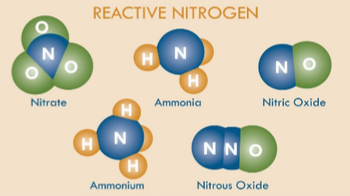FAQ
Nitrogen (N) is one of the building blocks of life: it is essential for all plants and animals to survive. Nitrogen (N2) makes up almost 80% of our atmosphere, but it is an unreactive form that is not accessible to us.
Humans and most other species on earth require nitrogen in a “fixed,” reactive form. Reactive nitrogen is necessasry for the food production process. Until the discovery of the Haber-Bosch process in the early 1900s, we only had access to naturally occurring sources of reactive nitrogen (such as manure and guano) for food production. The Haber-Bosch process--an industrial process through which we can fix reactive nitrogen--has allowed food production to keep up with the growing human population, but at a cost to the environment.
Today, humans create over 2 times as much reactive nitrogen as nature. In contrast, human activity contributes just 5-10% of CO2 emissions. Much of this reactive nitrogen has accummulated in the environment, where it causes a series of negative impacts to human and ecossytem health. Major sources of this reactive nitrogen include agriculture and the burning of fossil fuels. This nitrogen pollution causes profound environmental impacts, including smog, acid rain, forest dieback, coastal ‘dead zones’, biodiversity loss, stratospheric ozone depletion and increased greenhouse gases. It also affects human health, including respiratory disease and an increased risk for birth defects.

Reactive nitrogen (Nr) includes all forms of nitrogen that are biologically, photochemically, and radiatively active. Compounds of nitrogen that are reactive include the following: nitrous oxide (N2 O), nitrate (NO3 -), nitrite (NO2 -), ammonia (NH3), and ammonium (NH4 +). Reactive forms of nitrogen are those capable of cascading through the environment and causing an impact through smog, acid rain, coastal dead zones, biodiversity loss, etc.
The non-reactive form of nitrogen is N2 and makes up about 80% of our atmosphere. This form of nitrogen does not contribute to the environmental impacts noted above.
Unless otherwise noted, the term “nitrogen” or “N” on the N-Print website refers to “reactive nitrogen” – not its non-reactive diatomic form.
Nitrogen is an important nutrient for food production. Nitrogen can be applied to a field in a variety of forms such as synthetic fertilizer, manure, crop residue (green manure), or nitrogen fixed by legumes. Only some of the applied nitrogen is taken up by the plant--the rest remains in the soil or is lost to the environment through runoff and leaching to the waterways or volatilization to the atmosphere. Some additional nitrogen is lost during processing; only a fraction of the original nitrogen applied actually makes it into the final food product (embodied N). Virtual nitrogen is the rest: virtual nitrogen is any nitrogen that was used in the food production process but is not contained in the final food product that you consume. Stated another way, virtual nitrogen is the nitrogen lost to the environment throughout the food production process.
Virtual nitrogen factors are calculated to represent the entire food production process. These virtual nitrogen factors (VNF) consider N lost during fertilizer application, crop processing, food waste, and more. Once all of these inputs and losses are tallied, the nitrogen that you consume in your food can be subtracted out--the remaining amount is virtual nitrogen.
Most municipal sewer systems in the United States have primary or secondary treatment, which treat the human waste and break down its biological content. However, this level of treatment does not remove most of the reactive nitrogen. Only about 50% of homes in the US are attached to municipal sewer systems with tertiary treatment, which further break down nitrogen-waste to a non-reactive form (N2) that does not harm the environment.
If you your toilet is connected to a septic tank, you do not have tertiary treatment. If it is connected to a municipal sewage treatment plant you may have it. To find out if you have tertiary sewage treatment, contact your local municipal sewage treatment plant.
While some elements like electricity production are out of your control, there are many things that you can do to reduce your nitrogen footprint. Here are a few, stratified by food and energy – aspects of the N footprint:
Food
- A protein-heavy diet is nitrogen-intensive. The Dietary Reference Intake (DRI) recommendation is 0.36 grams of protein per pound of body weight per day for adults (or 0.8 g protein per kg body weight). If you eat more than your recommended protein intake, try replacing some protein with other types of food like fruits, vegetables and grains.
- A meat-heavy diet is also nitrogen-intensive. The animal proteins with the lowest nitrogen footprints are dairy, poultry and fish.
Energy
- Limit your household utility usage by using more efficient appliances.
- Choose more sustainable transportation methods like carpooling, public transit, bicycling, or walking.
- Reduce your consumption of goods and services by limiting unnecessary purchases, reusing, and recycling
It is important to note that doing many of these things even just one day a week can make a big difference over time. Most of these lifestyle changes will reduce not only your nitrogen footprint, but also your carbon footprint and your ecological footprint. These changes will generally lead you to live a more sustainable life.
